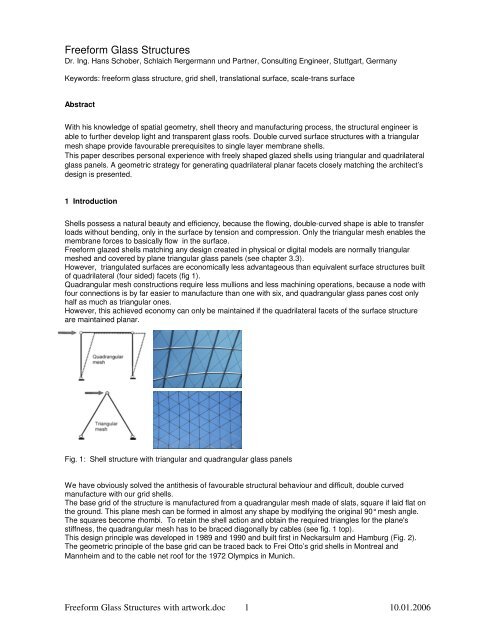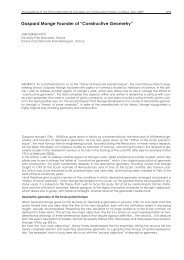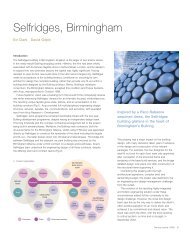link to article - formpig
link to article - formpig
link to article - formpig
You also want an ePaper? Increase the reach of your titles
YUMPU automatically turns print PDFs into web optimized ePapers that Google loves.
Freeform Glass Structures<br />
Dr. Ing. Hans Schober, Schlaich ergermann und Partner, Consulting Engineer, Stuttgart, Germany<br />
Keywords: freeform glass structure, grid shell, translational surface, scale-trans surface<br />
Abstract<br />
With his knowledge of spatial geometry, shell theory and manufacturing process, the structural engineer is<br />
able <strong>to</strong> further develop light and transparent glass roofs. Double curved surface structures with a triangular<br />
mesh shape provide favourable prerequisites <strong>to</strong> single layer membrane shells.<br />
This paper describes personal experience with freely shaped glazed shells using triangular and quadrilateral<br />
glass panels. A geometric strategy for generating quadrilateral planar facets closely matching the architect’s<br />
design is presented.<br />
1 Introduction<br />
Shells possess a natural beauty and efficiency, because the flowing, double-curved shape is able <strong>to</strong> transfer<br />
loads without bending, only in the surface by tension and compression. Only the triangular mesh enables the<br />
membrane forces <strong>to</strong> basically flow in the surface.<br />
Freeform glazed shells matching any design created in physical or digital models are normally triangular<br />
meshed and covered by plane triangular glass panels (see chapter 3.3).<br />
However, triangulated surfaces are economically less advantageous than equivalent surface structures built<br />
of quadrilateral (four sided) facets (fig 1).<br />
Quadrangular mesh constructions require less mullions and less machining operations, because a node with<br />
four connections is by far easier <strong>to</strong> manufacture than one with six, and quadrangular glass panes cost only<br />
half as much as triangular ones.<br />
However, this achieved economy can only be maintained if the quadrilateral facets of the surface structure<br />
are maintained planar.<br />
Fig. 1: Shell structure with triangular and quadrangular glass panels<br />
We have obviously solved the antithesis of favourable structural behaviour and difficult, double curved<br />
manufacture with our grid shells.<br />
The base grid of the structure is manufactured from a quadrangular mesh made of slats, square if laid flat on<br />
the ground. This plane mesh can be formed in almost any shape by modifying the original 90° mesh angle.<br />
The squares become rhombi. To retain the shell action and obtain the required triangles for the plane's<br />
stiffness, the quadrangular mesh has <strong>to</strong> be braced diagonally by cables (see fig. 1 <strong>to</strong>p).<br />
This design principle was developed in 1989 and 1990 and built first in Neckarsulm and Hamburg (Fig. 2).<br />
The geometric principle of the base grid can be traced back <strong>to</strong> Frei Ot<strong>to</strong>’s grid shells in Montreal and<br />
Mannheim and <strong>to</strong> the cable net roof for the 1972 Olympics in Munich.<br />
Freeform Glass Structures with artwork.doc 1 10.01.2006
Fig. 2 : Neckarsulm grid dome, left<br />
Geometric principle of grid shells, right: a square mesh when laid out in<strong>to</strong> a plane<br />
The previous example show the problem of double curved grid shells since the quadrangles are usually not<br />
plane. This is why the thermopanes of the spherical dome in Neckarsulm are spherically curved, resulting in<br />
an ideal but expensive spherical shape (fig. 3 bot<strong>to</strong>m). Parts of the free shaped and single glazed transition<br />
between the two barrel vaults of the roof in Hamburg had <strong>to</strong> be dissolved in<strong>to</strong> triangles in areas of extreme<br />
warping (fig. 3 <strong>to</strong>p).<br />
Fig. 3: Grid shell Museum für Hamburgische Geschichte (<strong>to</strong>p) and Neckarsulm dome (bot<strong>to</strong>m)<br />
Therefore, the construction of double curved shells with quadrangular meshes would be definitely restricted<br />
for technical and economical reasons, if there wouldn’t be a geometrical technique for designing almost any<br />
shape with plane quadrangles be available.<br />
Freeform Glass Structures with artwork.doc 2 10.01.2006
2 Basic geometric principles for planar quadrangles<br />
Having this problem in mind I developed during the last years a geometric strategy for generating<br />
quadrilateral planar facets for double-curved surfaces. The method is based on the simple principle<br />
that two spatial, parallel vec<strong>to</strong>rs are always defining a planar quadrangular surface.<br />
The vec<strong>to</strong>rs and the connection between their points of origin and end points make up the edge of<br />
the quadrangular surface.<br />
Fig. 4 Basic geometric principle for planar quadrangular meshes<br />
This is not the only method - but a rather simple one - because a planar surface may also be defined by two<br />
vec<strong>to</strong>rs not running parallel <strong>to</strong> each other.<br />
Assuming one direction of the quadrangular-meshed net <strong>to</strong> be the sectional curve with its individual sections<br />
being the lateral edges, and assuming the other direction with its individual sections being the longitudinal<br />
edges and regarding the two lateral resp. longitudinal edges as vec<strong>to</strong>rs, then this results in two design<br />
principles for plane quadrangular mesh:<br />
a) The longitudinal edges of a row of mesh form parallel vec<strong>to</strong>rs (Fig. 4 left).<br />
A special application of this is the translational surface.<br />
b) The lateral edges of a row of mesh form parallel vec<strong>to</strong>rs (Fig. 4 right).<br />
A special application of this is the scale-trans surface.<br />
2.1 The Translational Surface<br />
As published already in 1994 [1] and [2] translational surfaces permit a vast multitude of shapes for grid<br />
shells consisting of quadrangular planar mesh. Translating any spatial curve (generatrix) against another<br />
random spatial curve (directrix) will create a spatial surface consisting solely of planar quadrangular mesh<br />
(Fig. 5). Parallel vec<strong>to</strong>rs are the longitudinal and lateral edges. Subdividing the directrix and the generatrix<br />
equally results in a grid with constant bar length and planar mesh.<br />
Fig. 5 Geometric principle for translational surfaces<br />
If, for example, one parabola (generatrix) translates against another parabola (directrix) perpendicular <strong>to</strong> it,<br />
the result will be an elliptical paraboloid with an elliptic layout curve. Two identical parabolas generate a<br />
rotational paraboloid with a circular layout curve (Fig. 6). Innovative shapes may be created by adding<br />
translational surfaces (Fig. 6).<br />
Freeform Glass Structures with artwork.doc 3 10.01.2006
Fig. 6: Translational surface covering an elliptical or circular plan.<br />
Joining of translational surfaces (bot<strong>to</strong>m)<br />
A directrix curving anticlastically <strong>to</strong> the generatrix results in a hyperbolic paraboloid, which can also be<br />
formed by two systems of linear generatrices (Fig. 7). This allows for the creation of hypar-surfaces with<br />
straight edges which are easy <strong>to</strong> s<strong>to</strong>re and may be joined in a variety of combinations.<br />
All these examples consist of a grid with constant bar length and planar mesh.<br />
This paper will present only the basic possibilities. The variety in shapes is described in [1] and [2] .<br />
Fig. 7: Hyperbolic paraboloid as translational surface (<strong>to</strong>p) and joining possibility (bot<strong>to</strong>m)<br />
Freeform Glass Structures with artwork.doc 4 10.01.2006
2.2 Scale-Trans-Surfaces<br />
The centric expansion of any sectional curve yields a new one with parallel edges (Fig. 8). The center of<br />
expansion may be chosen at random. Centric expansion causes each lateral edge vec<strong>to</strong>r of the sectional<br />
curve <strong>to</strong> lengthen or shorten by the same fac<strong>to</strong>r, while maintaining its direction. Thus from the (n)th sectional<br />
curve evolves the similar (n+1)th sectional curve which is then spatially translated – although without rotation<br />
– <strong>to</strong> any given spot (Fig. 9). The longitudinal edges are determined by the line between the points of origin<br />
and the end points of the respective lateral edge vec<strong>to</strong>rs. The next row of mesh will be created following the<br />
same principle with the shape of the new sectional curve depending on the selected expansion fac<strong>to</strong>r. Thus<br />
row after row is generated.<br />
Fig. 8: Scaling a curve centrically or eccentrically results in parallel lateral edges<br />
To obtain homogenous structures analytical curves such as circles, ellipses, hyperbolas or polynomials may<br />
be divided equally (identical lateral edge length) and expanded centrically. Translating the center of<br />
expansion of the resulting sectional curves along an analytical spatial curve (directrix) and adjusting the<br />
translational distance <strong>to</strong> the expansion fac<strong>to</strong>r results in homogenous surfaces with longitudinal edges of the<br />
same length in each mesh, and lateral edges of the same length in each sectional curve. Fig. 9 shows a<br />
double-curved surface with plane quadrangular mesh created by centrically expanding elliptical curves and<br />
translating the center of expansion along a spatially curved directrix. The generatrix and directrix curve in<br />
Fig. 10 is composed of randomly chosen curves.<br />
Fig. 9: Surfaces with plane quadrangular meshes are generated by scaling and translation.<br />
Fig. 10: Example of a scale-trans surface with plane quadrangular facets<br />
Freeform Glass Structures with artwork.doc 5 10.01.2006
3 Reference Projects by our Consultancy<br />
To demonstrate the different geometric principles some projects of our office have been selected and are<br />
described below.<br />
3.1 Translational Surfaces<br />
The principle of an evenly-meshed translational surface with different parabolas as generatrix and directrix<br />
was first realized in 1992 with the roof over an elliptical courtyard in Ros<strong>to</strong>ck, Germany (Fig. 11).<br />
A parabola (generatrix) translating across another parabola (directrix) perpendicular <strong>to</strong> it, results in an elliptic<br />
layout curve and an evenly-meshed net consisting of plane quadrangular meshes.<br />
The filigree shell consists of solid slats 60mm wide and 40mm deep.<br />
Fig. 18<br />
Fig. 11: Gallery Ros<strong>to</strong>cker Hof, Ros<strong>to</strong>ck, Germany, grid dome as translational surface<br />
The roof over the square courtyard of the German His<strong>to</strong>ric Museum in Berlin was generated using identical<br />
circles as generatrix and directrix. Since the roof is only point supported at the four corners, the grid was<br />
oriented in the direction of the flow of forces, that means in diagonal direction.<br />
Due <strong>to</strong> the small rise, the mullions are 60mm wide and 140mm deep.<br />
Fig. 12: Courtyard roof of the German His<strong>to</strong>rical Museum, Berlin (Arch. I.M. Pei, 2002)<br />
Grid dome as translational surface with planar meshes<br />
Freeform Glass Structures with artwork.doc 6 10.01.2006
However, directrix and generatrix must not necessarily consist of geometrically simple curves but can also be<br />
defined as random spatial curves, and thus offer a huge variety of shapes.<br />
A recent example is the hippopotamus-house in the Berlin Zoo. Two parabolas with a freely defined<br />
transition curves were chosen as a directrix for the roof over two circular ponds (Figs. 13). The double<br />
glazing rests directly on mullions only 40mm wide and 40mm deep.<br />
Fig. 13: Glass dome of the Hippo House at the Berlin Zoo as translational surface with planar quadrangular<br />
mesh<br />
Another example of designing rather difficult geometries as translational surfaces is the roof over a courtyard<br />
in Stuttgart (Bosch Areal), Germany. Although in this case there are several adjoining irregular courtyards, it<br />
was possible <strong>to</strong> create a continuously curved transition area consisting solely of plane and evenly meshed<br />
quadrangles with 40mm wide and 60mm deep flat bars(Fig. 14).<br />
Freeform Glass Structures with artwork.doc 7 10.01.2006
Fig. 14: . Courtyard roof of the former Bosch Area, Stuttgart, Germany (Arch. Prof. Ostertag, Stuttgart)<br />
Grid shell as translational surface with planar mesh<br />
3.2 Scale-Trans Surfaces<br />
The plan of the glass roof over the platform of the new Lehrter railroad station in Berlin follows strictly the<br />
flaring tracks. The three-centered arch cross-section of the roof, as shown in Fig. 15, allows for optimum<br />
adjustment <strong>to</strong> the clearance and <strong>to</strong> the flaring tracks. The sectional curve was determined by centric<br />
expansion and a slight rotation according the curved tracks, leading <strong>to</strong> a grid with planar quadrangular<br />
meshes. Thus the rise of the hall and the roof’s profile increases with the flaring, an effect which rather<br />
enhances the design.<br />
Fig. 15: Platform roof of the Lehrter railroad station in Berlin (Arch. von Gerkan Marg und Partner Hamburg).<br />
Plane quadrangular glass panels obtained by centric expansion and translation<br />
of the sectional curves<br />
Freeform Glass Structures with artwork.doc 8 10.01.2006
An example for the design of freeform structures is the Jerusalem Museum of Tolerance project currently<br />
under design at Gehry Partners in collaboration with our office. This voluminous complex is a multifunctional<br />
group of building components, which are each given individual design characters within the context of the<br />
overall design (Figure 16). A major component of the project is a series of large, freeform glass structures.<br />
One of them, the atrium roof, is described here.<br />
Fig. 16: Computer model of Jerusalem Museum of Tolerance<br />
The challenge here lies not only in the development of a geometric strategy for generating quadrilateral<br />
planar facet solutions, but also in the fact that said solutions must closely match the designs created initially<br />
in physical model form by the architects.<br />
For the atrium roof we used the scale-trans method in order <strong>to</strong> be able <strong>to</strong> approximate the translation surface<br />
as much as possible <strong>to</strong> the original designed shape. The control of the surface is achieved by combining a<br />
combination of any of the following:<br />
I. Modifying the control points for the directrix curve;<br />
II. Modifying the control points for the generatrix curve;<br />
III. Modifying the scaling law for the whole generatrix curve or only for parts of it.<br />
Due <strong>to</strong> the constraints of the translation surface, it is not possible <strong>to</strong> perfectly match the original surface, but<br />
the combination of translation and scaling gets quite close.<br />
Fig. 17 shows the result of the form-finding process resulting in a very complex grid shell with planar<br />
quadrilateral facets.<br />
Fig. 17: Atrium roof as a scale-trans surface with flat quadrangular facets,<br />
matching closely the designers form (Arch. F.O.Gehry, Santa Monica)<br />
Freeform Glass Structures with artwork.doc 9 10.01.2006
3.3 Sculptural shapes<br />
We often face the challenge of designing sculptural or freeform shapes matching perfectly the created<br />
physical or digital model form. Since such forms usually can no longer be covered by plane quadrangular<br />
panes, the economically less favourable triangular panes have <strong>to</strong> be used.<br />
The architect F.O. Gehry designed for the DZ Bank in Berlin a three-dimensional barrel shaped atrium roof<br />
as a sculpture intervening with the interior (fig. 18).<br />
Free shapes like this can only be glazed with triangles and made from a triangular grid. The shell structure is<br />
point supported along the edges at 16m intervals. Due <strong>to</strong> the barrel like shape the shell had <strong>to</strong> be additionally<br />
stiffened by ‘spoked wheels’ (fig 18 bot<strong>to</strong>m). The entire structure is made of stainless steel. The nodes were<br />
milled three-dimensionally.<br />
Fig. 18: DZ Bank’s sculptured roof in Berlin (Arch. F.O. Gehry, Santa Monica)<br />
Freeform Glass Structures with artwork.doc 10 10.01.2006
References<br />
[1] Schober, H.: Die Masche mit der Glaskuppel, Netztragwerke mit ebenen Maschen.<br />
Deutsche Bauzeitung 128 (1994), S. 152-163.<br />
[2] Schober, H.: Geometrie-Prinzipien für wirtschaftliche und effiziente Schalentragwerke.<br />
Bautechnik 79 (2002), H. 1, S. 16-24<br />
Freeform Glass Structures with artwork.doc 11 10.01.2006








